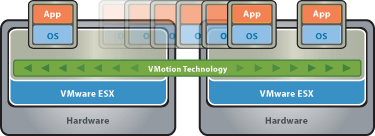What’s VMware VMotion?
VMware VMotion enables the active migration of running virtual machines from one physical server to another without interruption of service, availability of service and complete integrity of transactions.
VMware VMotion moves running virtual machines from one physical server to another while maintaining service availability.
VMware VMotion allows IT organizations to:
- Perform live migrations with zero downtime, undetectable to the user.
- Continuously and automatically optimize virtual machines within resource pools.
- Perform hardware maintenance without scheduling downtime and disrupting business operations.
- Proactively move virtual machines away from failing or underperforming servers.
VMotion is a key technology which makes the creation of dynamic data center, automation and optimization possible.
When to use VMware VMotion?
- To Perform hardware maintenance without having to schedule an interruption of service (Downtime)
- Migrate virtual machines from servers with flaws or poor performance proactively .
- Any time you have a schedule downtime for the host (Ex: updating the VMware ESX)
How does VMotion work?
The active migration of a virtual machine from one physical server to another with VMotion is made possible by three underlying technologies.
First, the full status of a virtual machine is encapsulated by a set of files stored in shared data storage, such as storage area networks (SAN) served using Fiber Channel or iSCSI, as well the cluster virtual machine file system (VMFS) allows multiple VMware ESX Servers to access the same files of the virtual machine concurrently.
Second, active memory and precise execution state of the virtual machine to be quickly transferred via a high speed network, allowing the virtual machine to instantly move from the ESX Server running it to the destination ESX Server. VMotion makes the period of transfer transparent to users by keeping track of transactions taking place while the migration in progress in a memory bitmap. Once the memory and the full system state are copied to the destination ESX Server, VMotion suspends the source virtual machine, copies the bitmap to the destination ESX Server and resumes the virtual machine on the destination ESX Server . This whole process takes less than two seconds on a Gigabit Ethernet network.
Third, the ESX Server virtualizes the networks used by the virtual machine, which ensures that after the migration the identity & network connections of the virtual machine is preserved. VMotion manages the virtual MAC address as part of the process. Once the machine is activated on the destination server VMotion ping the network router to ensure its aware of the new location for the virtual MAC address. Since the migration of a virtual machine with VMotion preserves the precise status of the network identity & active network connection, the result is a zero downtime & zero interruption to the service.
Key Features of VMware VMotion
• Reliability. Tested by thousands of customers in production environments since 2004, VMotion still setting the standard for the functionality of active migration reliability.
• Performance. Perform migrations of active service without interruption and in a manner transparent to end users. The optimal use of the CPU and the network ensures that the active migration be carried out quickly and efficiently.
• Interoperability. Migrate virtual machines that run on any operating system across any type of data storage hardware which supported by VMware ESX Server.



Hello,
I am still a little confused because of the two theories that I have come across.
First is the one you have mentioned in this article that says vmotion makes use of memory bitmap.
The second one says vmotion works by making use of multiple pre-copies and doing mutiple iteration of this precopy as has been mentioned here in :
http://blogs.vmware.com/uptime/2011/02/vmotion-whats-going-on-under-the-covers.html
Can you please validate which one correctly details as to how vmotion works
Thanks.
Hi Gaurav,
I am not sure why are you confusing between the two explanations, as the memory bitmap is kinda needed to ensure what need to be copied on subsequent copies. VMotion need away to figure out what has been already copied and what is the new bit of data in memory. So we are both explaining kinda the same thing just a different wording.
Enjoy,
Eiad